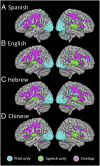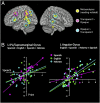Universal brain signature of proficient reading: Evidence from four contrasting languages
- PMID: 26621710
- PMCID: PMC4687557
- DOI: 10.1073/pnas.1509321112
Universal brain signature of proficient reading: Evidence from four contrasting languages
Abstract
We propose and test a theoretical perspective in which a universal hallmark of successful literacy acquisition is the convergence of the speech and orthographic processing systems onto a common network of neural structures, regardless of how spoken words are represented orthographically in a writing system. During functional MRI, skilled adult readers of four distinct and highly contrasting languages, Spanish, English, Hebrew, and Chinese, performed an identical semantic categorization task to spoken and written words. Results from three complementary analytic approaches demonstrate limited language variation, with speech-print convergence emerging as a common brain signature of reading proficiency across the wide spectrum of selected languages, whether their writing system is alphabetic or logographic, whether it is opaque or transparent, and regardless of the phonological and morphological structure it represents.
Keywords: cross-language invariance; functional MRI; word recognition.
Conflict of interest statement
The authors declare no conflict of interest.
Figures






Similar articles
-
The brain signature of emerging reading in two contrasting languages.Neuroimage. 2021 Jan 15;225:117503. doi: 10.1016/j.neuroimage.2020.117503. Epub 2020 Oct 24. Neuroimage. 2021. PMID: 33130273
-
Impact of language proficiency and orthographic transparency on bilingual word reading: an fMRI investigation.Neuroimage. 2006 Feb 15;29(4):1135-40. doi: 10.1016/j.neuroimage.2005.08.055. Epub 2005 Oct 18. Neuroimage. 2006. PMID: 16242351
-
How Characters Are Learned Leaves Its Mark on the Neural Substrates of Chinese Reading.eNeuro. 2022 Dec 21;9(6):ENEURO.0111-22.2022. doi: 10.1523/ENEURO.0111-22.2022. Print 2022 Nov-Dec. eNeuro. 2022. PMID: 36635247 Free PMC article.
-
A meta-analysis of fMRI studies on Chinese orthographic, phonological, and semantic processing.Neuroimage. 2012 Oct 15;63(1):381-91. doi: 10.1016/j.neuroimage.2012.06.047. Epub 2012 Jul 1. Neuroimage. 2012. PMID: 22759996 Review.
-
Cultural neurolinguistics.Prog Brain Res. 2009;178:159-71. doi: 10.1016/S0079-6123(09)17811-1. Prog Brain Res. 2009. PMID: 19874968 Free PMC article. Review.
Cited by
-
Disrupted network interactions serve as a neural marker of dyslexia.Commun Biol. 2023 Nov 3;6(1):1114. doi: 10.1038/s42003-023-05499-2. Commun Biol. 2023. PMID: 37923809 Free PMC article.
-
Spatiotemporal Dynamics of Activation in Motor and Language Areas Suggest a Compensatory Role of the Motor Cortex in Second Language Processing.Neurobiol Lang (Camb). 2023 Mar 8;4(1):178-197. doi: 10.1162/nol_a_00093. eCollection 2023. Neurobiol Lang (Camb). 2023. PMID: 37229145 Free PMC article.
-
Towards a dynamic, comprehensive conceptualization of dyslexia.Ann Dyslexia. 2024 Oct;74(3):303-324. doi: 10.1007/s11881-023-00297-1. Epub 2024 Jan 13. Ann Dyslexia. 2024. PMID: 38217783 Free PMC article.
-
Is there evidence for a noisy computation deficit in developmental dyslexia?Front Hum Neurosci. 2022 Sep 30;16:919465. doi: 10.3389/fnhum.2022.919465. eCollection 2022. Front Hum Neurosci. 2022. PMID: 36248689 Free PMC article.
-
Cortical asymmetries at different spatial hierarchies relate to phonological processing ability.PLoS Biol. 2022 Apr 5;20(4):e3001591. doi: 10.1371/journal.pbio.3001591. eCollection 2022 Apr. PLoS Biol. 2022. PMID: 35381012 Free PMC article.
References
-
- Seymour PHK, Aro M, Erskine JM. Foundation literacy acquisition in European orthographies. Br J Psychol. 2003;94(Pt 2):143–174. - PubMed
-
- Ziegler JC, Goswami U. Reading acquisition, developmental dyslexia, and skilled reading across languages: A psycholinguistic grain size theory. Psychol Bull. 2005;131(1):3–29. - PubMed
-
- Velan H, Frost R. Cambridge University versus Hebrew University: The impact of letter transposition on reading English and Hebrew. Psychon Bull Rev. 2007;14(5):913–918. - PubMed
-
- Frost R, Katz L, Bentin S. Strategies for visual word recognition and orthographical depth: A multilingual comparison. J Exp Psychol Hum Percept Perform. 1987;13(1):104–115. - PubMed
Publication types
MeSH terms
Grants and funding
LinkOut - more resources
Full Text Sources
Other Literature Sources

